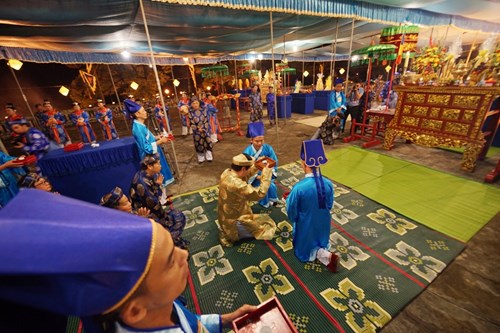April 27, 2018 | 14:15 (GMT+7)
Hue festival: Heaven-and-Earth-worshipping ritual re-enacted
The Giao ritual (worshipping ritual for Heaven and Earth) was re-enacted at the Nam Giao Esplanade in the central province of Thua Thien-Hue on April 27, the twelfth day of the third lunar month.
It is one of the main events during the Hue Festival 2018, which is scheduled in Thua Thien-Hue from April 27 to May 2.
The Giao ritual was the most important ritual of the Nguyen dynasty (1802-1945). In the ritual, the King offered sacrifices to Heaven and Earth to ask for peace, prosperity and favourable weather. It was held until 1945. Built in 1906, Nam Giao was the largest esplanade of the country.
    |
 |
|
At the ritual. Photo: baothuathienhue.vn |
Hue city was the imperial capital of Vietnam for hundreds of years. It is home to five UNESCO-recognised heritages, namely the Hue ancient citadel relic complex – a World Cultural Heritage site; Nha Nhac (Hue royal court music)- an intangible cultural heritage item; Nguyen Dynasty’s wood blocks – a documentary heritage item; Nguyen Dynasty’s Chau ban (royal administrative documents) – part of the Asia-Pacific Register of UNESCO’s Memory of the World Programme; and literature on Hue royal architecture - a documentary heritage.
Themed “Cultural heritage with integration and development - Hue one destination, five world heritages”, the Hue Festival 2018 comprises an array of activities, including a Buddhism cultural programme, Hue Royal Essences art programme, Huong River’s resonance programme, a national festival of “Hat Van” or “Chau Van” (a traditional art form that combines singing and dancing), a music show featuring songs of late musician Trinh Cong Son, a scientific festival, an international trade fair, a cuisine fair and a poem festival.
This year, the festival is organised in association with numerous cultural events such as 25 years since the Hue ancient citadel relic complex recognised by the UNESCO as a world cultural heritage and 15th anniversary of the Hue royal court music recognised by the UNESCO as a Masterpiece of Oral and Intangible Heritage of Humanity.
Source: VNA